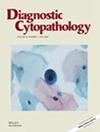细针穿刺多形性腺瘤的诊断缺陷:肌上皮细胞的退行性改变为恶性和PLAG1假阴性
IF 1
4区 医学
Q4 MEDICAL LABORATORY TECHNOLOGY
引用次数: 0
摘要
细针抽吸(FNA)被广泛接受为评估唾液腺病变的有效一线诊断工具。它可以准确诊断大多数常见的良性肿瘤,包括多形性腺瘤(PA)。然而,PA可以表现出广泛的形态变化,这可能导致误解。在这里,我们提出一个病例,其中退行性肌上皮细胞与核异型性PA被误解为恶性。此外,细胞阻断材料中PLAG1假阴性加剧了诊断挑战。本报告旨在通过提供一个说明性的例子来强调这一诊断陷阱并提醒细胞病理学家。本文章由计算机程序翻译,如有差异,请以英文原文为准。

Diagnostic Pitfalls in Fine Needle Aspiration of Pleomorphic Adenoma: Degenerative Changes in Myoepithelial Cells as Malignant and PLAG1 False Negativity
Fine needle aspiration (FNA) is widely accepted as an efficient first-line diagnostic tool for evaluating salivary gland lesions. It can accurately diagnose a majority of common benign tumors, including pleomorphic adenoma (PA). However, PA can exhibit a wide range of morphological variations, which may lead to misinterpretation. Here, we present a case in which degenerative myoepithelial cells with nuclear atypia in PA were misinterpreted as malignant. Furthermore, PLAG1 false negativity in cell block material compounded the diagnostic challenge. This report aims to highlight this diagnostic pitfall and alert cytopathologists by providing an illustrative example.
求助全文
通过发布文献求助,成功后即可免费获取论文全文。
去求助
来源期刊

Diagnostic Cytopathology
医学-病理学
CiteScore
2.60
自引率
7.70%
发文量
163
审稿时长
3-6 weeks
期刊介绍:
Diagnostic Cytopathology is intended to provide a forum for the exchange of information in the field of cytopathology, with special emphasis on the practical, clinical aspects of the discipline. The editors invite original scientific articles, as well as special review articles, feature articles, and letters to the editor, from laboratory professionals engaged in the practice of cytopathology. Manuscripts are accepted for publication on the basis of scientific merit, practical significance, and suitability for publication in a journal dedicated to this discipline. Original articles can be considered only with the understanding that they have never been published before and that they have not been submitted for simultaneous review to another publication.
 求助内容:
求助内容: 应助结果提醒方式:
应助结果提醒方式:


